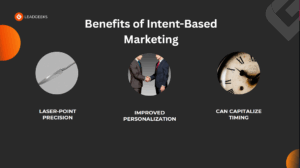Looking to connect better with your B2B audience? Intent-based marketing may be your missing key. It’s all about getting to know what your potential customers really want and giving it to them when they want it. In this post, we will be learning about a marketing strategy that speaks directly to buyer interests.
What is Intent-Based Marketing?
Imagine if you could read your client’s mind—intent-based marketing is kind of like that, but without the crystal ball. It lets you peek into the intentions behind a customer’s online activities. Are they just browsing? Are they ready to buy?
By understanding these patterns, you can make sure your marketing efforts fit snugly with what your audience is after.
Types of Intent Data
Internal Intent Data
From your owned channels (website visits, email clicks, webinar attendance).
External Intent Data
From third-party platforms (keyword searches, social media interactions, competitor mentions).
The Perks of Intent-Based Marketing for B2B
Pinpoint Precision
The beauty of intent-based marketing is its laser-focused targeting. B2B buying can be a maze with lots of decision-makers. With intent data, you can identify prospects who are actively researching products or services like yours, allowing you to focus your efforts on the most promising leads.
Key Intent Signals to Monitor for Precision
Search Behavior
- Identify high-intent keywords (e.g., “best cloud ERP for manufacturing,” “CRM migration challenges”).
- Track long-tail queries that indicate urgency (e.g., “urgent need for compliance software”).
Content Consumption
- Pages visited (pricing, case studies, vs. blogs).
- Time spent on technical documentation vs. product overviews.
Engagement Patterns
- Repeated visits to competitor comparison pages.
- Downloads of ROI calculators or implementation guides.
Enhanced Personalization
Personalization is crucial in modern marketing, especially for B2B where relationships play a critical role. Intent-based marketing empowers you to personalize your messaging and content effectively. By understanding what each prospect is interested in, you can tailor your communications to address their specific concerns, goals, and where they stand in the decision-making process.
Example of Personalization Strategies
Dynamic Content Tailoring
- Show different website banners or CTAs based on visitor industry (e.g., healthcare vs. manufacturing).
- Adjust email content to reflect a prospect’s recent activity (e.g., “Here’s how our solution addresses the challenges you researched”).
Account-Specific Storytelling:
- Reference a prospect’s recent milestones (e.g., “Congrats on your Series B funding! Here’s how we helped similar startups scale”).
- Use pain points uncovered in intent data to craft narratives (e.g., “Struggling with lab downtime? Here’s how we fixed it for [Peer Company]”).
Behavioral Trigger Campaigns
- Send a case study after a prospect attends a webinar.
Timing Mastery
Ever heard “timing is everything”? Well, in marketing, it’s true. Intent-based marketing clues you in on the right time to make your move, so your message hits home and doesn’t get lost in the inbox.
How to Capitalize Timing
Lead Scoring & Thresholds
- Define thresholds for immediate action (e.g., “Score >75 = Sales call within 1 hour”).
- Automate alerts for high-intent signals (e.g., “Prospect X viewed pricing 3x today”).
Real-Time Retargeting
- Launch ad campaigns targeting prospects who abandoned a demo sign-up.
- Use sequential messaging (e.g., “Missed our webinar? Here’s the recap + exclusive Q&A”).
Lifecycle Sync
- Align outreach with prospect’s business cycles (e.g., budget planning seasons, post-funding announcements).
Implementing Intent-Based Marketing in Your Business
Collect and Analyze Intent Data
You’ll need some handy tools like Google Analytics for website data, SEMRush or Ahrefs for search insights, and BuzzSumo for a peek into which content is hot. These gems help you track what your audience is into and how they hunt for relevant info.
Segment Your Audience
Categorize your audience based on their behavior, interactions and engagement levels. This way, you can dish out content that aligns perfectly with what each group is searching for. This may take awhile to do manually, so try to make it more automated using CRM systems such as Salesforce or HubSpot.
Create Tailored Content
Design content that sticks with tools like WordPress and optimization helpers like Yoast SEO. Whether you’re crafting a blog post or a white paper, make sure it’s tailored to answer your potential customers’ burning questions.
Engaging the Right Way
The goal is to keep ’em coming back for more. Tools like Smartreach and Apollo can help automate personalized emails and content delivery based on user behavior. And don’t just guess—A/B test your strategies to keep improving!
The Tech Advantage
There are AI tools like IBM Watson or Brandwatch that can sift through heaps of data to give you the edge in what content goes well with your targeting strategies. These tools can allow you to easily prioritize efforts on leads with the highest purchase intent.
Intent-based marketing is all about making your B2B marketing personal and spot-on. No more shooting in the dark; it’s time to meet your buyers where they are and deliver exactly what they’re looking for. Adopt intent-based marketing, and watch your connections—and conversions—grow.
If this post has been resourceful for you so far, why not read more? We provide more insights like this in our blog! Learn more and stay up-to-date to current B2B marketing strategies by following us here.
















Hey there! I wanted to take a moment to let you know how much I enjoyed this blog post. Your insights were incredibly helpful and thought-provoking. It’s clear that you put a lot of effort into your writing. Thank you for sharing your expertise with us. Looking forward to your next post!
Thank you for your feedback! I’m thrilled you found it helpful and engaging. More insights are coming your way soon!
Greetings! I found this blog post to be incredibly informative and well-written. Your ability to break down complex topics into easy-to-understand language is truly a gift. Thank you for sharing your knowledge with us. I’m excited to read more of your posts in the future!
Thank you so much for your kind words! It’s a pleasure to share knowledge with readers like you. Stay tuned for more!
Business to Business Marketing Strategies
Intent-Based Marketing: A Guide to Targeting the Right Audience
Hi! I just finished reading your blog post, and I must say, it was excellent. Your ability to explain complicated concepts in a simple and engaging way is truly remarkable. Thank you for providing such valuable content. I can’t wait to read more from you in the future.
Thanks! Glad you found it helpful. Check out our other content here for more tips.
Thank you for this wonderful post! I found it very informative and engaging. Your thorough research and clear writing style made it easy to understand. I appreciate the time and effort you put into creating this valuable content. Keep up the excellent work.
Thank you for your kind words! I’m glad you found the post informative and engaging.
Hello! I wanted to drop by and say that I really enjoyed this blog post. Your writing is always so clear and concise, and you have a talent for making.
Thank you! This made my day.
Thank you for this fantastic post! The information you provided is very useful and well-explained. I especially liked how you broke down complex concepts into easily understandable parts. Your writing is clear and concise, making it a pleasure to read. Looking forward to more of your posts.
glad to know that you find it helpful. Thank you!
Hi! I found this blog post to be incredibly insightful and well-written. Your ability to break down complex topics into easy-to-understand language is truly a gift. Thank you for sharing your knowledge with us. I’m excited to read more of your posts in the future!
I am grateful for your encouragement. Keep watching, I will keep posting.
This post was a breath of fresh air. Thank you for The unique insights!
Thank you!. I will keep it coming.